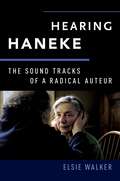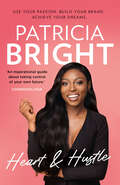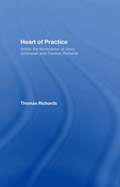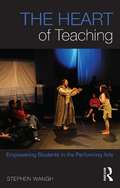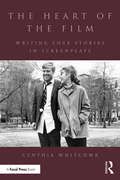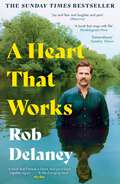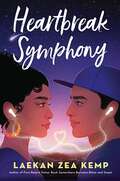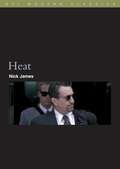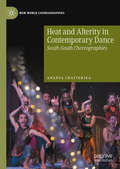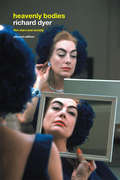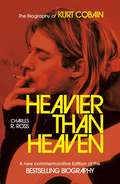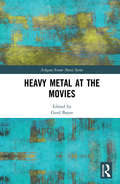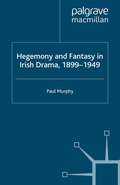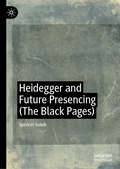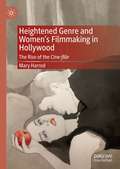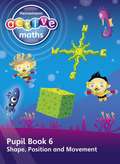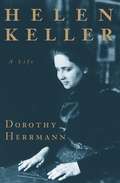- Table View
- List View
Hearing Haneke: The Sound Tracks of a Radical Auteur (Oxford Music/Media Series)
by Elsie WalkerMichael Haneke's films subject us to extreme experiences of disturbance, desperation, grief, and violence. They are unsoftened by music, punctuated by accosting noises, shaped by painful silences, and charged with aggressive dialogue. The sound tracks are even more traumatic to hear than his stories are to see, but they also offer us the transformative possibilities of reawakened sonic awareness. Haneke's use of sound redefines cinema in ways that can help us re-hear everything-including our own voices, and everything around us-better. Though Haneke's films make exceptional demands on us, he is among the most celebrated of living auteurs: he is two-time receipt of the Palme D'Or at Cannes Film Festival (for The White Ribbon (2009) and Amour (2012)), and Academy Award winner of Best Foreign Language Film (for Amour), along with numerous other awards. The radical confrontationality of his cinema makes him an internationally controversial, as well as revered, subject. Hearing Haneke is the first book-length study of the sound tracks that define this living legacy. This book explores the haunting, subversive, and political significance of all aural elements through Haneke's major feature films (dialogue, sound effects, silences, and music), all of which are meticulously conducted by him. Many critics read Haneke as coolly dispassionate about showing scenes of humanity under threat, but Hearing Haneke argues that all facets of his sound tracks stress humane understanding and the importance of compassion. This book provides exceptionally detailed analyses of all Haneke's most celebrated films: including The Seventh Continent, Funny Games, Code Unknown, The Piano Teacher, Caché, The White Ribbon, and Amour. The writing brings together film theory, musicology, history, and cultural studies in ways that resonate broadly. Hearing Haneke will matter to anyone who cares about the power of art to inspire progressive change.
HEARING HANEKE OMMS C: The Sound Tracks of a Radical Auteur (Oxford Music/Media Series)
by Elsie WalkerMichael Haneke's films subject us to extreme experiences of disturbance, desperation, grief, and violence. They are unsoftened by music, punctuated by accosting noises, shaped by painful silences, and charged with aggressive dialogue. The sound tracks are even more traumatic to hear than his stories are to see, but they also offer us the transformative possibilities of reawakened sonic awareness. Haneke's use of sound redefines cinema in ways that can help us re-hear everything-including our own voices, and everything around us-better. Though Haneke's films make exceptional demands on us, he is among the most celebrated of living auteurs: he is two-time receipt of the Palme D'Or at Cannes Film Festival (for The White Ribbon (2009) and Amour (2012)), and Academy Award winner of Best Foreign Language Film (for Amour), along with numerous other awards. The radical confrontationality of his cinema makes him an internationally controversial, as well as revered, subject. Hearing Haneke is the first book-length study of the sound tracks that define this living legacy. This book explores the haunting, subversive, and political significance of all aural elements through Haneke's major feature films (dialogue, sound effects, silences, and music), all of which are meticulously conducted by him. Many critics read Haneke as coolly dispassionate about showing scenes of humanity under threat, but Hearing Haneke argues that all facets of his sound tracks stress humane understanding and the importance of compassion. This book provides exceptionally detailed analyses of all Haneke's most celebrated films: including The Seventh Continent, Funny Games, Code Unknown, The Piano Teacher, Caché, The White Ribbon, and Amour. The writing brings together film theory, musicology, history, and cultural studies in ways that resonate broadly. Hearing Haneke will matter to anyone who cares about the power of art to inspire progressive change.
Heart and Hustle: Use Your Passion. Build Your Brand. Achieve Your Dreams
by Patricia Bright‘Patricia Bright is killing it right now’ Glamour ‘One of Britain’s biggest YouTube stars’ Huffington Post ‘I’m going to show you how to hustle like I do, using your head and heart. All it takes is three steps…’
Heart of Practice: Within the Workcenter of Jerzy Grotowski and Thomas Richards
by Thomas RichardsHeart of Practice is a unique and invaluable insight into the workings of one of theatre’s true pioneers, presented by his closest collaborator. This book charts the development of Grotowski’s dramatic research through a decade of conversations with his apprentice, Thomas Richards. Tuscany’s ‘Workcenter of Jerzy Grotowski and Thomas Richards’ is the enduring legacy of a master teacher, director and theorist, and home to much of Grotowski’s most significant work. Interviewed by leading scholars, and offering his own intimate accounts, Richards gives a vivid and detailed view of the Workcenter’s evolution, providing: concrete illustration of the Workcenter’s distinctive creative practices rigorous discussion of over twenty years of world-renowned research previously unpublished performance photos privileged insight into what Grotowski considered to be the culmination of his life’s work.
Heart of Practice: Within the Workcenter of Jerzy Grotowski and Thomas Richards
by Thomas RichardsHeart of Practice is a unique and invaluable insight into the workings of one of theatre’s true pioneers, presented by his closest collaborator. This book charts the development of Grotowski’s dramatic research through a decade of conversations with his apprentice, Thomas Richards. Tuscany’s ‘Workcenter of Jerzy Grotowski and Thomas Richards’ is the enduring legacy of a master teacher, director and theorist, and home to much of Grotowski’s most significant work. Interviewed by leading scholars, and offering his own intimate accounts, Richards gives a vivid and detailed view of the Workcenter’s evolution, providing: concrete illustration of the Workcenter’s distinctive creative practices rigorous discussion of over twenty years of world-renowned research previously unpublished performance photos privileged insight into what Grotowski considered to be the culmination of his life’s work.
The Heart of Teaching: Empowering Students in the Performing Arts
by Stephen WanghThe Heart of Teaching is a book about teaching and learning in the performing arts. Its focus is on the inner dynamics of teaching: the processes by which teachers can promote—or undermine—creativity itself. It covers the many issues that teachers, directors and choreographers experience, from the frustrations of dealing with silent students and helping young artists ‘unlearn’ their inhibitions, to problems of resistance, judgment and race in the classroom,. Wangh raises questions about what can—and what cannot—be taught, and opens a discussion about the social, psychological and spiritual values that underlie the skills and techniques that teachers impart. Subjects addressed include: Question asking: which kinds of questions encourage creativity and which can subvert the learning process. Feedback: how it can foster both dependence and independence in students. Grading: its meaning and meaninglessness. Power relationships, transference and counter-transference The pivotal role of listening. The Heart of Teaching speaks to experienced teachers and beginning teachers in all disciplines, but is particularly relevant to those in the performing arts, from which most of its examples are drawn. It brings essential insight and honesty to the discussion of how to teach.
The Heart of Teaching: Empowering Students in the Performing Arts
by Stephen WanghThe Heart of Teaching is a book about teaching and learning in the performing arts. Its focus is on the inner dynamics of teaching: the processes by which teachers can promote—or undermine—creativity itself. It covers the many issues that teachers, directors and choreographers experience, from the frustrations of dealing with silent students and helping young artists ‘unlearn’ their inhibitions, to problems of resistance, judgment and race in the classroom,. Wangh raises questions about what can—and what cannot—be taught, and opens a discussion about the social, psychological and spiritual values that underlie the skills and techniques that teachers impart. Subjects addressed include: Question asking: which kinds of questions encourage creativity and which can subvert the learning process. Feedback: how it can foster both dependence and independence in students. Grading: its meaning and meaninglessness. Power relationships, transference and counter-transference The pivotal role of listening. The Heart of Teaching speaks to experienced teachers and beginning teachers in all disciplines, but is particularly relevant to those in the performing arts, from which most of its examples are drawn. It brings essential insight and honesty to the discussion of how to teach.
The Heart of the Film: Writing Love Stories in Screenplays
by Cynthia WhitcombMost movies include a love story, whether it is the central story or a subplot, and knowing how to write a believable relationship is essential to any writer's skill set. Discover the rules and laws of nature at play in a compelling love story and learn and master them. Broken into four sections, The Heart of the Film identifies the critical features of love story development, and explores every variation of this structure as well as a diverse array of relationships and types of love. Author Cynthia Whitcomb has sold over 70 feature-length screenplays and shares the keys to her success in The Heart of the Film, drawing on classic and modern films as well as her own extensive experience.
The Heart of the Film: Writing Love Stories in Screenplays
by Cynthia WhitcombMost movies include a love story, whether it is the central story or a subplot, and knowing how to write a believable relationship is essential to any writer's skill set. Discover the rules and laws of nature at play in a compelling love story and learn and master them. Broken into four sections, The Heart of the Film identifies the critical features of love story development, and explores every variation of this structure as well as a diverse array of relationships and types of love. Author Cynthia Whitcomb has sold over 70 feature-length screenplays and shares the keys to her success in The Heart of the Film, drawing on classic and modern films as well as her own extensive experience.
A Heart That Works
by Rob DelaneyIn this memoir of loss, acclaimed writer and comedian Rob Delaney grapples with the fragile miracle of life, the mysteries of death, and the question of purpose for those left behind.When you're a parent and your child gets hurt or sick, you not only try to help them get better but you also labour under the general belief that you can help them get better. That's not always the case though. Sometimes the nurses and the doctors can't fix what's wrong. Sometimes children die.Rob Delaney's beautiful, bright, gloriously alive son Henry died. He was one when he was diagnosed with a brain tumour. An experience beyond comprehension, but an experience Rob must share. Why does he feel compelled to talk about it, to write about it, to make people feel something like what he feels when he knows it will hurt them? Because, despite Henry's death, Rob still loves people. For that reason, he wants them to understand.A Heart That Works is an intimate, unflinching and fiercely funny exploration of loss - from the harrowing illness to the vivid, bodily impact of grief and the blind, furious rage that follows, through to the forceful, unstoppable love that remains. This is the story of what happens when you lose a child, and everything you discover about life in the process.
Heartbreak Symphony
by Laekan Zea KempClap When You Land meets On the Come Up in this heart-gripping story about navigating first love and overcoming grief through the power of music. Aarón Medrano has been haunted by the onstage persona of his favorite DJ ever since his mother passed away. He seems to know all of Aarón&’s deepest fears, like how his brain doesn&’t work the way it should and that&’s why his brother and father seem to be pushing him away. He thinks his ticket out is a scholarship to the prestigious Acadia School of Music. That is, if he can avoid blowing his audition.Mia Villanueva has a haunting of her own and it&’s the only family heirloom her parents left her: doubt. It&’s the reason she can&’t overcome her stage fright or believe that her music is worth making. Even though her trumpet teacher tells her she has a gift, she&’s not sure if she&’ll ever figure out how to use it or if she&’s even deserving of it in the first place. When Aarón and Mia cross paths, Aarón sees a chance to get close to the girl he&’s had a crush on for years and to finally feel connected to someone since losing his mother. Mia sees a chance to hold herself accountable by making them both face their fears, and hopefully make their dreams come true. But soon they&’ll realize there&’s something much scarier than getting up on stage—falling in love with a broken heart.
Heartbreak Symphony
by Laekan Zea KempClap When You Land meets On the Come Up in this heart-gripping story about navigating first love and overcoming grief through the power of music. Aarón Medrano has been haunted by the onstage persona of his favorite DJ ever since his mother passed away. He seems to know all of Aarón&’s deepest fears, like how his brain doesn&’t work the way it should and that&’s why his brother and father seem to be pushing him away. He thinks his ticket out is a scholarship to the prestigious Acadia School of Music. That is, if he can avoid blowing his audition.Mia Villanueva has a haunting of her own and it&’s the only family heirloom her parents left her: doubt. It&’s the reason she can&’t overcome her stage fright or believe that her music is worth making. Even though her trumpet teacher tells her she has a gift, she&’s not sure if she&’ll ever figure out how to use it or if she&’s even deserving of it in the first place. When Aarón and Mia cross paths, Aarón sees a chance to get close to the girl he&’s had a crush on for years and to finally feel connected to someone since losing his mother. Mia sees a chance to hold herself accountable by making them both face their fears, and hopefully make their dreams come true. But soon they&’ll realize there&’s something much scarier than getting up on stage—falling in love with a broken heart.
Heat (BFI Film Classics)
by Nick JamesRobert de Niro and Al Pacino have acted opposite each other once, and that was in Heat, Michael Mann's operatic 1995 heist thriller. De Niro is Neil McCauley, a skilled professional thief at the centre of a tight-knit criminal team; Pacino is Vincent Hanna, the haunted, driven cop determined to hunt him down. Boasting a series of meticulously orchestrated setpieces that underline Mann's sense of scale and architecture, Heat is also a rhapsody to Los Angeles as Hanna closes in on his prey. For Nick James, the pleasures and virtues of Heat are mixed and complex. Its precise compositions and minimalist style are entangled with a particular kind of extravagant bombast. And while its vision of male teamwork is richly compelling it comes close to glorifying machismo. But these complexities only add to the interest of this hugely ambitious and accomplished film, which confirmed Mann's place in the front rank of American film-makers.
Heat (BFI Film Classics)
by Nick JamesRobert de Niro and Al Pacino have acted opposite each other once, and that was in Heat, Michael Mann's operatic 1995 heist thriller. De Niro is Neil McCauley, a skilled professional thief at the centre of a tight-knit criminal team; Pacino is Vincent Hanna, the haunted, driven cop determined to hunt him down. Boasting a series of meticulously orchestrated setpieces that underline Mann's sense of scale and architecture, Heat is also a rhapsody to Los Angeles as Hanna closes in on his prey. For Nick James, the pleasures and virtues of Heat are mixed and complex. Its precise compositions and minimalist style are entangled with a particular kind of extravagant bombast. And while its vision of male teamwork is richly compelling it comes close to glorifying machismo. But these complexities only add to the interest of this hugely ambitious and accomplished film, which confirmed Mann's place in the front rank of American film-makers.
Heat and Alterity in Contemporary Dance: South-South Choreographies (New World Choreographies)
by Ananya ChatterjeaThis book argues that contemporary dance, imagined to have a global belonging, is vitiated by euro-white constructions of risk and currency that remain at its core. Differently, the book reimagines contemporary dance along a “South-South” axis, as a poly-centric, justice-oriented, aesthetic-temporal category, with intersectional understandings of difference as a central organizing principle. Placing alterity and heat, generated via multiple pathways, at its center, it foregrounds the work of South-South artists, who push against constructions of “tradition” and white-centered aesthetic imperatives, to reinvent their choreographic toolkit and respond to urgent questions of their times. In recasting the grounds for a different “global stage,” the argument widens its scope to indicate how dance-making both indexes current contextual inequities and broader relations of social, economic, political, and cultural power, and inaugurates future dimensions of justice.
Heavenly Bodies: Film Stars and Society (Bfi Cinema Ser.)
by Richard DyerRichard Dyer's classic study of movie stars and stardom has been updated, with a new introduction by the author discussing the rise of celebrity culture and developments in the study of stars since publication of the first edition in 1986. Dyer's illuminating study is based around case studies of three major stars: Marilyn Monroe, Paul Robeson and Judy Garland. He draws on a wide range of sources, including the films in which each star appeared, to illustrate how each star's persona was constructed, and goes on to examine each within the context of particular issues in fan culture and stardom. Students of film and cultural studies will find this an invaluable part of there course reading.
Heavenly Bodies: Film Stars and Society
by Richard DyerRichard Dyer's classic study of movie stars and stardom has been updated, with a new introduction by the author discussing the rise of celebrity culture and developments in the study of stars since publication of the first edition in 1986. Dyer's illuminating study is based around case studies of three major stars: Marilyn Monroe, Paul Robeson and Judy Garland. He draws on a wide range of sources, including the films in which each star appeared, to illustrate how each star's persona was constructed, and goes on to examine each within the context of particular issues in fan culture and stardom. Students of film and cultural studies will find this an invaluable part of there course reading.
Heavier Than Heaven: The Biography of Kurt Cobain
by Charles R. CrossAlongside the death of Elvis Presley and the assassination of John Lennon, Kurt Cobain's suicide in 1994 ranks as one of the generational milestones of American life - an epochal event in both rock 'n' roll and youth culture. This book is the story of Kurt Cobain's life, from abject poverty to unbelievable wealth, power and fame. It traces the journey from his humble origins in Aberdeen to becoming lead singer of Nirvana, the most popular rock band in the world from 1991 to 1994, and the most influential band of this decade. The beautifully written text is complimented by 16 pages of photographs.Based on over one hundred interviews, Charles Cross allows us to understand Kurt Cobain's personality. This is an incredible tale of a strange, tortured and very talented man.
Heavy Metal at the Movies (Ashgate Screen Music Series)
by Gerd BayerThe chapters collected in this volume shed light on the areas of interaction between film studies and heavy metal research, exploring how the audio-visual medium of film relates to, builds on and shapes metal culture. At one end of the spectrum, metal music serves as a form of ambient background in horror films that creates an intense and somewhat threatening atmosphere; at the other end, the high level of performativity attached to the metal spectacle is emphasized. Alongside these tendencies, the recent and ongoing wave of metal documentaries has taken off, relying on either satire or hagiography.
Heavy Metal at the Movies (Ashgate Screen Music Series)
by Gerd BayerThe chapters collected in this volume shed light on the areas of interaction between film studies and heavy metal research, exploring how the audio-visual medium of film relates to, builds on and shapes metal culture. At one end of the spectrum, metal music serves as a form of ambient background in horror films that creates an intense and somewhat threatening atmosphere; at the other end, the high level of performativity attached to the metal spectacle is emphasized. Alongside these tendencies, the recent and ongoing wave of metal documentaries has taken off, relying on either satire or hagiography.
Hegemony and Fantasy in Irish Drama, 1899-1949
by P. MurphyHegemony and Fantasy in Irish Drama, 1899-1949 offers a theoretically innovative reconsideration of drama produced in the Irish Renaissance, as well as an engagement with non-canonical drama in the under-researched period 1926-1949.
Heidegger and Future Presencing (The Black Pages)
by Spencer GolubThis book applies Heidegger’s writings to experimental fictions and film genres in order to study a being-there that performs itself beyond liveness and a future that is already here. Theatrical mise-en-scène is analyzed as a way of modeling the Heideggerian ontological-existential, exchanging a deeper presencing for the fictional “now” of liveness. The book is organized around ostensible objects that are in fact things-as-such and performs its theme via time-traveling, interruptions, decompositions, incompleteness, failure, geometric patterning, and above all black pages first cited in Tristram Shandy. This is a nuanced, original work that combines unexpected sources with even more unexpected writing, imagery, and correspondences. It is part of Golub’s ongoing project of lyrically reimagining philosophy and the mise-en-scène of theatrical performance (a presence-room of consciousness) in light of one another.
Heightened Genre and Women's Filmmaking in Hollywood: The Rise of the Cine-fille
by Mary HarrodDespite the widely publicised prejudice faced by women in Hollywood, since around 1990 a significant minority of female directors have been making commercially and culturally impactful films there across the full range of genres. This book explores movies by filmmakers Amy Heckerling, Nora Ephron, Nancy Meyers, Catherine Hardwicke, Sofia Coppola, Kimberly Peirce, Kathryn Bigelow and Greta Gerwig, including many which are still critically neglected or derided, seeing them as offering a new understanding of genre filmmaking. That is, like many other contemporary films but in a striking proportion within the smaller set of mainstream movies by women, this body of work revels in a heightened genre status that allows its authors to simultaneously address ‘intellectual’ cinephilic pleasures and bodily-emotive ones. Arguing through close analysis that these films demonstrate the inseparability of such strategies of engagement in contemporary genre cinema, Heightened Genre reclaims women’s mainstream filmmaking for feminism through a recalibration of genre theory itself.
Heinemann Active Maths, Level 1, Pupil Book 6: Shape, Position and Movement (PDF)
by Lynda Keith Steve Mills Hilary KollThese bright and lively pupil books have been designed to further consolidate children's learning through independent practice. They are closely linked to the teacher activity cards and each 'Heinemann Active Maths' outcome.
Helen Keller: A Life
by Dorothy HerrmannDorothy Herrmann's powerful biography of Helen Keller tells the whole story of the controversial and turbulent relationship between Helen and her teacher, Annie Sullivan. Herrmann also chronicles Helen's doomed love affair, her struggles to earn a living, her triumphs at Radcliffe College, and her work as an advocate for the disabled. Helen Keller has been venerated as a saint or damned as a fraud, but Herrmann shows her to have been a beautiful, intelligent, high-strung, and passionate woman whose life was transformed not only by her disabilities but also by the remarkable people on whose help and friendship she relied. "Fascinating. . . . Stripping away decades of well-meaning sentimentality, Herrmann presents a pair of strong-willed women, who struggled to build their own lives while never forgetting their dependence on each other."—Ron Charles, Christian Science Monitor "We meet an entirely unexpected Helen Keller—a woman with deep if concealed ambivalence toward her self-sacrificing teacher; a political radical; and a woman longing for romantic love and the fulfilled sexual life of a woman."—Joan Mellen, Philadelphia Inquirer "Herrmann's portrait of Keller is both fully embodied and unflinchingly candid."—Mary Loeffelholz, Boston Sunday Globe "This well-proportioned biography of the deaf and blind girl who became a great American crusader rescues its subject from the shackles of sainthood without destroying her as an American hero."—Dennis Drabelle, Cleveland Plain Dealer "Herrmann's engrossing biography helps us see beyond the public's fascination with how Keller dealt with her disabilities to discover the woman Keller strived to be."—Nancy Seidman, Atlanta Journal-Constitution "Perhaps the most intimate biography [of Helen Keller]. [Herrmann] gives her back her sexuality [and] imbues her with a true humanity. . . . Helen Keller: A Life has some of the texture and the dramatic arc of a good novel."—Dinitia Smith, New York Times
